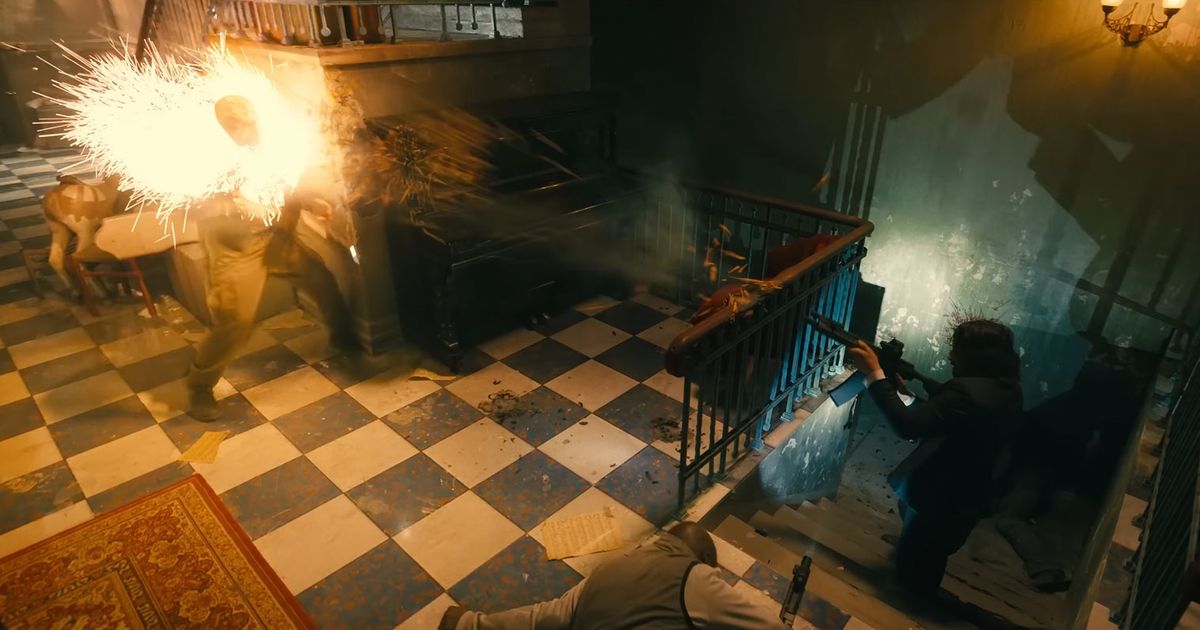
One Take. Three Days. A Painstaking Dance.
Over three ultraviolent, neon-lit, mythologically elaborate films, we’ve seen Keanu Reeves’s reluctant assassin John Wick do it all. How to (maybe) wrap the franchise with a final installment that gives audiences something new? A trio of white-knuckle action sequences in John Wick: Chapter 4’s final hour seemed like the answer. All are set in Paris — the first one in the traffic circle around the Arc de Triomphe, the last hurling Wick down the 222 stairs leading to the Sacré-Cœur Basilica. But the sequence in the middle, an apartment-set shoot-out, posed a problem.
“The staircase I knew I could own because it was a metaphor for Sisyphus rolling the boulder up the hill and being knocked down. We had that dialed in; we had the Arc de Triomphe dialed in,” director Chad Stahelski says. “The apartment fight wasn’t clicking. It was just a fight in an apartment. And I’m like, How do we shift perspective?” The former stuntman, who has helmed every John Wick installment, found the “special sauce” of inspiration in the 2019 video game Hong Kong Massacre, which unfolds from a bird’s-eye view. “There was a visual there that shouldn’t have made sense but did,” he says. “It was part video game, part anime, part cinematic experience.”
Stahelski and the crew turned this shoot-out into one of the most visually arresting segments of the entire John Wick franchise. The camera’s smooth movement, the explosive bursts of light from the Dragon’s Breath ammunition, the choreography required to nail the one-take shot — it all combines into what cinematographer Dan Laustsen calls “a really good gag.”
“You want it to feel natural”

![]()
Photo: YouTube
When the scene begins, the space is so bluish black that Wick and his assailants look almost like silhouettes — until the first Dragon’s Breath round explodes. The searing light from the shotguns is entrancing and creates new shadows and distractions.
The set was lit by a mixture of tungsten, LED, and neon lights placed outside the apartment (“Each room had to have a different character,” Laustsen says), while the explosions created by the Dragon’s Breath rounds were created digitally. Stahelski held on to the idea of using the flammable ammo specifically for the top-down shot to add life to a scene that would otherwise be spent “looking at the same color floor.”
Without the Dragon’s Breath, “the shot would be a lot more boring. It wouldn’t last half as long,” explains Rogers. (Stahelski recalls Laustsen’s similar reaction to the top-down idea: “What are you, crazy? That’s going to bore the crap out of people.”)
Stahelski asked himself, “How many different colors can I put in this scene? How beautiful can I make it?” The eureka moment: “Screw it. I’m just going to light people on fire.”
The crew couldn’t use actual Dragon’s Breath rounds, so Laustsen and his team used a flame gun to create a lighting reference for the visual-effects department, which later added the sparks and flares. Visual effects also helped maintain continuity when Wick’s assailants catch fire in the apartment’s kitchen (done practically by the stunt team) and when the scene briefly cuts to some ground action of Wick fending off attackers.
But the rest of the scene was shot as a oner. Stunt coordinator Steve Dunlevy kept the beat, counting from 1 to 60 on a microphone so everyone could hit their marks at the right time, from the staircase opening and initial camera drift, through the kitchen fire — which took more than 30 takes, Stahelski says — and ending with Wick and the Tracker chasing each other through the apartment before the former jumps out a window. “We shot the whole thing in less than three days,” Stahelski says.
At the wrap, the cast and crew knew they had something special — an “entertaining” and “ludicrous” effort, as Rogers puts it, that captures what makes a John Wick movie a John Wick movie. But in the editing room, Stahelski found himself fighting to keep the sequence in. He’s glad he won.
“When you see the top shot without all the cool effects and you don’t see any of the Dragon’s Breath coming out with the muzzle flashes, what do you think is on the cutting table? Until pretty much the end, that was on the list that a lot of other people thought we should cut,” Stahelski says. “It wasn’t until we put in the temp visual effects that people go, ‘Oh, fuck. We didn’t think it was going to be anything like that.’ And I’m like, ‘Good thing we didn’t cut it.’”
Additional reporting by Vulture senior reporter Chris Lee.





























![iFi's GO Bar Kensei Dongle DAC Supports K2HD Technology With Some Samurai Swagger [Updated] iFi's GO Bar Kensei Dongle DAC Supports K2HD Technology With Some Samurai Swagger [Updated]](https://i0.wp.com/cdn.ecoustics.com/db0/wblob/17BA35E873D594/33FF/45A11/QTXOLJR4xDKSNMMk2WlTgjaIlvSgcYpeU1xJzUwIoYs/ifi-go-bar-kensei.jpg?w=768&ssl=1)






















